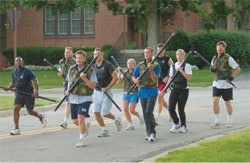An Air Force Base fitness director steers his program toward combat readiness.
 Runners
Runners
"That's not what I do," he says. "One of our fitness instructors here is a contractor, and she plays music and all that sort of crud. I have got our people carrying litters loaded with sandbags, carrying telephone poles as they're running. If our guys can't throw a body on a litter and carry it 100 yards, they're gonna be hurting when they actually get deployed."
Links believes that, in general, Air Force fitness is sorely lacking, but he has come to the conclusion gradually. When he started leading classes, he says, "I used to just yell at them for 40 minutes, make them do different exercises." Now class participants are taken outside and run through various combat-related scenarios. Sometimes Links goes "Cool Hand Luke" on them, as he did in a blinding rainstorm last fall, commanding his class to build a levee out of sandbags, then to dismantle it, and then to build it again. Now the focus is moving toward close-combat skills. Over the past several months he began experimenting with pugil-stick training in his classes, and starting last month, he began teaching a full-fledged, full-contact close-combat program involving boxing, grappling, Kendo, thai kickboxing, pugil sticks and self-defense training.
"We're not going to go to war in fitness centers, and we're not going to go to war on a basketball court," Links says. "If we have to play basketball or volleyball or do step aerobics against the insurgents, we'll kick their ass. We do a lot of that in our fitness programs. But when it comes to war-fighting skills, I'm not sure we're doing all that well."
Health-club "boot camps" are a civilian-world trend with civilian-world teachers and participants. Boot-camp classes led by actual boot-camp veterans is the real coming thing. Last fall, for example, Craig Robbins, a two-tour platoon guide in the U.S. Marine Corps, taught "Boot Camp Aerobics" at the North Liberty Recreation Center in Iowa City, Iowa. Attired in his uniform, the 23-year-old Robbins led classes in push-ups and jumping jacks, motivating participants with command-and-response counting and other, equally noisy techniques.
Robbins concedes the experience bore little relation to the grueling 13-week program that recruits endure. "Some of the stuff that's done in recruit training you really couldn't recreate in a civilian environment - for example, we used to pick up our bunk beds and carry them around for half an hour," he says. "Also, I went back and forth about how much of the military aspect I was going to project. When I got to the first class, I immediately toned down everything that I was going to do. I mean, even if my classes were a month long, I still couldn't recreate the feeling that recruits have, of knowing that they're legally obligated to stay there and finish the training. In the civilian world, they're your clients, and you want them to have a good experience and to come back. In the military, drill instructors don't really care if you're having a good experience or not."
Links' classes attract civilians as well as active-duty personnel, but he hasn't seen a need to tone down his approach at all. Having the active support of his commanding officers has helped. When a young lieutenant who was new to the base groused to the colonel that, "If I wanted to do this, I'd join the Army," he was told, "You're in Links' Army."
"I have got boatloads of civilians," Links says of his pugil-stick clients. "I have got a lady who's in her mid-50s, and she's there flailing away." He also has a group of eight chaplains (he calls them the "Battling Chaplains") who have proven to be his most apt pupils. "At first they said, `We're not required to carry weapons,' " Links says. "I told them, `You tell that to a Muslim insurgent, he's going to kill you anyway. If you want to carry on the word of God, you might want to stay alive.' "
It is that pragmatic worldview that keeps driving Links' program further from the flag football field and closer to the battlefield. Almost from the first class, his incorporation of martial arts laid bare participants' lack of fighting skills - "a lot of grown males who don't know how to make a fist," he says, "and people who get waxed on a daily basis because they won't aggressively go after someone." This might be expected in a military realm in which the number of actual fighters is dwarfed by those in combat support - office workers, drivers, stockers of equipment - but, as Links notes, the line between the two is a lot narrower than it used to be.
"The Air Force is going to the AOR, the area of responsibility, and doing things like convoy duty, which was traditionally an Army responsibility," he says. "Not only that, but we have women out there now, and they have to be made to understand contact. If a unit is deployed, either those women hold their own or they become a liability."
All of this explains the quick progression in Links' classes - from indoor shouting to outdoor combat scenarios to the soon-to-be-constructed, full-scale obstacle courses that are much more prevalent on Army bases than on Air Force bases. It also explains a parallel progression - from martial arts moves, to striking opponents below the neck, to participants wearing helmets and face guards to allow contact above the neck, to participants wearing chest protectors and gloves.
"It's high-intensity training," Links says. "It's hitting. I want to maintain the health and fitness portion of the program, but I want to get it more geared toward deployment operations. We have got to get our military people ready to make contact."





































